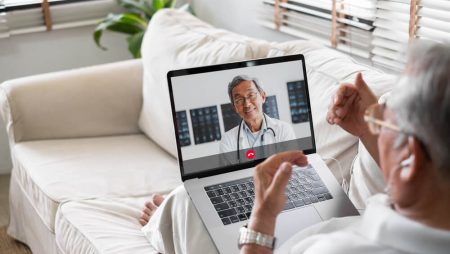



Get new exclusive access to healthcare business reports & breaking news






The healthcare industry is experiencing a technology-driven rebirth.
Over the past year, medical centers reported usage of telehealth tools has increased by 52%, according to CDC data. And, it seems patients will continue to seek out telehealth services even in a post-pandemic world. A report by Doctor.com revealed that 83% of patients expect to continue using telemedicine even after the virus has passed, with intuitive and simple technology being a key component of this shift.
Digital innovation in the medical field has forced healthcare organizations to take a “human-first” approach to both patients and providers on the frontlines. It has significantly impacted how healthcare personnel spend their days, interact with patients, and access data. Yet, despite advances, there is still significant work to be done to create a truly seamlessly connected health experience for both patients and physicians.
In Deloitte’s 2020 Physician Survey, 84% of physicians said that ease of use and seamless integration of technology are essential, yet 82% said these elements were lacking in their practice.
As we move farther into a digital-centric future, user-friendly connected patient-doctor experiences will become crucial to modern medical practices and organizations. This article will cover Covid-19’s impact on healthcare technology, the evolution of telemedicine and virtual practice management over the past year-and-a-half, and how healthcare organizations can leverage technology to their advantage while still remaining personal.
Covid has proven that everything can change in an instant. When the world stopped in March of 2020, we were forced to shift the way we work, shop, live, and even visit doctors. While the virus emphasized shortcomings in the U.S. healthcare system, it also started it on the path to course correction—and digital innovation has played a huge role in that new path.
The early phase of the pandemic caused many health systems to shift into crisis mode and implement virtual health processes that had been sorely lacking before. These initial solutions were shaky at first; however, they have quickly evolved over the last 18 months. Now, as we move into recovery mode, patients expect a more refined telemedicine experience, and are rethinking the very nature of healthcare overall.
Much like we don’t assume we have to be in an office five days a week to work successfully, we’re re-evaluating and applying the same critical thought to our healthcare choices. Do I need to see a doctor in person for that? Does my sales rep need to visit the clinic live? How else can I communicate with patients impactfully?
Health systems are scaling up their virtual capabilities—from digitalizing administrative tasks to utilizing wearables to monitor patient health—and it’s improving patient-doctor relationships and outcomes. However, it’s worth noting that the sustained popularity of telehealth will likely depend on big health insurance payers’ continued coverage of these services.
Tech innovation in healthcare has been a longtime coming, but medical systems have been traditionally slow to adopt new methods of practice management and treatment. Now that the pandemic has propelled us into a virtual environment, the race for digital innovation is on.
The key to success will be less disruption and more evolution and widespread adoption, ultimately improving accessibility to physicians, information, and services.
Currently, more than two-thirds of Americans feel that the healthcare process is a chore, so much so that more than half of consumers have avoided seeking care because of the perceived difficulties.
Technology has the power to change that. Artificial Intelligence (AI) can be used to create chatbot or virtual concierge assistance to guide patients through the more opaque parts of the healthcare system, like benefits. This helps remove the friction of a task that might feel more like a chore, and helps us design for a more human experience.
By making things like benefits an experience that people want to engage with, AI can make it easier for them to live a healthier life.
The operational efficiencies enabled by technology also have the ability to remove time-consuming tasks from physicians that don’t require genuine medical expertise, allowing medical professionals to spend more time in front of patients instead of a computer.
Administrative tasks like scheduling and billing can be allocated to AI. Paper trails and filing cabinets have been replaced by digital forms and cloud storage, allowing for increased facetime between doctors and patients.
Connected Care
By integrating information from many different sources across health care providers, life sciences, pharmaceuticals, insurance companies, and others, the healthcare industry will evolve to become much more efficient. There will be a concerted effort to create a virtual world that informs the physical world, making everything from where doctors get their equipment to how we buy our medicine much more seamless.
Cigna’s 2018 merger with Express Scripts to form Evernorth is one such example of how technology has already helped update the cycle of connected care. Evernorth brings together Cigna’s vast array of health services capabilities, as well as those of partners from across the health care system, in pharmacy solutions, benefits management, care solutions, and data and analytics. The new brand opened the door to a reevaluation of Cigna’s services.
According to Amy Monshausen, CMO of Evernorth at Cigna, “We knew that we had an opportunity strategically with the business to look at the offerings we had across the entire portfolio to see what we might be able to do differently to deliver more value in healthcare…to create net new things for the market that our competitors couldn’t.”
Furthermore, leveraging analytics around management and utilization of a digital practice can help eliminate redundancies in health systems. Analyzing things like practice management expenses or inefficient sourcing processes can provide an opportunity for medical organizations to optimize costs, saving patients money in the long run.
Technology should not make practices less personal. Rather, it holds serious potential to further connect healthcare professionals with their patients, and design processes that will best serve everyone. But to do this, organizations must redefine what their prioritized metrics mean in practice for patients and providers.
Based on research done by R/GA, there are three principles health organizations should be using to drive human-first health systems: (1) accessible, (2) informed, and (3) relationship-driven.
This human-centered way of thinking should be used in strategic decision making, as well as technology investments. These principles align with providers’ best interests by providing more choice in how they practice via supporting digital tools, how they stay informed, and how they can spend more time with their patients, which is what providers overwhelmingly want.
The healthcare industry has been slow to adopt virtual tools—whether it be for practice management, supply chain solutions, or patient communications—and suffered the consequences of these delays at the start of the pandemic. But now that we have shifted as a society to a digital-first environment, patients will continue to expect increasingly efficient telehealth services. Luckily, health providers seem to be on board with an on-demand medical experience, especially as younger generations enter the healthcare industry.
Looking ahead, technology has the potential to make healthcare experiences more personal and more meaningful, while simultaneously providing greater insights to individualized health data, and better access to supply chain data.